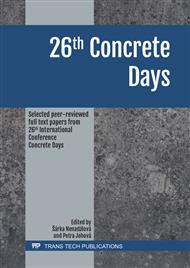p.222
p.228
p.234
p.240
p.246
p.252
p.261
p.267
p.272
Reconstruction Effectiveness of Locally Supported Flat Slabs to Increase in Shear Resistance
Abstract:
The most used horizontal load-bearing systems in concrete buildings are flat slabs. The effective and economic reconstruction of a locally supported flat slab of an existing building creates a complex task. Shear stress arises near the column and it becomes critical in design with increasing slab slenderness and requires a more detailed calculation. Increasing in the shear resistance of the flat slab can be achieved in various ways. Each method brings different effectiveness, advantages and disadvantages. The most widely used methods of the reconstruction are the increase in the size of the column (therein increasing the control perimeter for displaying the shear stress), the increase in the thickness of the flat slab or reinforcing the slab with shear reinforcement. Bolts and screw anchors (using different mounting angles) can be used as shear reinforcement. Each mentioned reconstruction method should be subjected to numerical calculations and verification of its efficiency. The parametric study presented in this paper is focused on the reconstruction techniques and their verification according to various numerical models. The results from Eurocode 2, fib Model Code 2010 and the new generation of Eurocode 2 are compared to show the differences between them. The aim of this paper is to bring a demonstration of the reconstruction methods that will increase in the shear resistance of the locally supported flat slabs and trying to choose the most effective one.
Info:
Periodical:
Pages:
246-251
Citation:
Online since:
August 2020
Authors:
Keywords:
Price:
Сopyright:
© 2020 Trans Tech Publications Ltd. All Rights Reserved
Share:
Citation:


